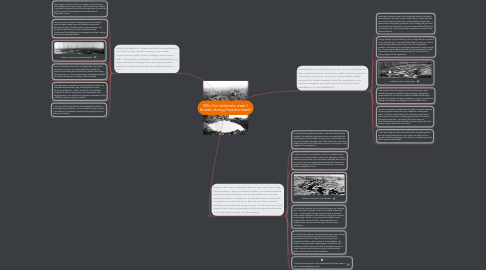Why the stalemate wasn't broken during Passchendaele
by sai sivayogarayan

1. When the Battle of Passchendaele is mentioned, it is hard to go past the severe WEATHER CONDITIONS with which soldiers were faced with. The horrific conditions of the battlefield are often related to being the main aspect which caused another stalemate at Passchendaele in 1917
1.1. Rain began to fall on the 4th of October, and continued without stop for the next 3 days. The torrential rain soaked the battlefield ground, which had already been churned up by the incessant bombardment and movement of thousands of men
1.2. Three months of constant shelling prior to the rainfall at Passchendaele Ridge meant that watercourses were blocked off, which usually would provide drainage. This caused the obliteration of rivers and streams,and transformed the battlefield into a quagmire of mud, making movement extremely difficult
1.3. horrific conditions at Passchendaele
1.4. Trench lines became almost unrecognizable, due to the immense amounts of mud and water which filled the ditches. One wrong step could send a soldier knee deep into the mud, or in some cases being completely engulfed, and slowly drowning in the deep craters created.
1.5. The significant consequences of the horrific conditions at Passchendaele was the huge difficulty that men and tanks succumbed to. Artillery could not hold positions properly, due to the placement of the footings on the soggy ground. This meant that it proved impossible for the artillery to advance during an attack.
1.6. “We could not believe that we were expected to attack in such appalling conditions. I never prayed so hard in my life. I got down on my knees in the mud and prayed to God to bring me through.”
2. TRENCHES are an integral part of any war, and a key component in any successful battle. In Passchendaele however, trenches were unrecognizable due to the severe weather conditions, and water and mud which covered most and if not all the trench lines. These conditions prevented proper uses of the trenches, and meant that new impromptu methods were undertaken in an attempt to take out the enemy.
2.1. With the severe weather condition, a horrific battlefield was created. This affected most trench lines, and meant that the trenches were not available for proper use. Fortunately this occurred for both the British and Allied sides, but meant that soldiers would have to stay above ground, making them easy targets for the opposition.
2.2. As trenches were so important at war, this created several problems at Passchendaele. Tactics and strategies of either side were abandoned, and impromptu methods were called upon. Even for those soldiers placed within the trenches, a single wrong step could send them deep into a crater, and become engufled in mud.
2.3. Soldiers in packed in the trenches
2.4. The flooded trenches and churned landscape are amongst the most potent symbols of not only Passchendaele but WW1. Much physical danger and implications occurred within these conditions, from finding a dry spot to sleep to simply using a toilet. Many troops succumbed to such physical harm as 'trench foot'. These were seen as invitations for rats and lice who would feed on such 'delicacies'.
2.5. The terrible conditions at Passchendaele were very inviting for such pests as rats, frogs and lice. In the horrific environment, rats and frogs thrived, proving a real nuisance and killer in some cases to many soldiers. The smell of rotting corpses, lingering gas, wet clothes and unwashed soldiers all produced an over powering stench. These horrible smells hardened the list of discomforts faced in the trenches of Passchendaele
2.6. "The trenches were of no use, they were filled knee deep in mud. We were fighting in hell"
3. During the course of any war, WEAPONS are seen as the most important utensils for either side to ensure a successful outcome. However, the problem which aroused at Passchendaele was the inability to use certain weapons and vehicles due to the horrific conditions of the battlefield.
3.1. Tanks were relatively new to the battlefield during the time of Passchendaele, and plans were created which surrounded the use of such tanks by either side. Unfortunately however, the tanks proved completely pointless as they simply just got stuck. As they were sent forward one by one to assist the infantry, the tanks would sink in the swamp like conditions and prove to be without benefit
3.2. During the war, a signal would go off, and signaled the moment to 'go over the top'. This meant that soldiers would run into no mans land and attempt to kill as many of the opposition possible, whilst being left completely exposed to shells and gun fire. This act proved especially difficult at Passchendaele, when men would move much slower through the mud and act as sitting targets for the opposition.
3.3. Soldiers using machine guns
3.4. Whilst such advanced weapons as the machine gun were available during the Passchendaele campaign, using them proved difficult. The horrific conditions meant that the legs wouldn't sit straight and were constantly moving. They became slightly less effective, and wasted much valueable time.
3.5. Machine guns were relatively new to battle, and were capable of gunning down 2000 men from a distance of 200 yards away. This was a well known fact, and severe precautions were taken to avoid the constant gunning down of soldiers through the rapid fire. This meant that there were no advancements across the battlefield, meaning that each side stayed on their side of no mans land.
3.6. "With each step we took, the constant fear of getting shot in the back of the head stuck in our minds. We awoke to the sounds of shells exploding in the distance, a deafening sound which we will never forget."


